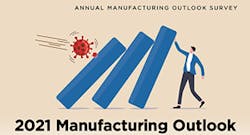Hopeless optimist that I am, I’m going to assume the coronavirus pandemic is winding down. Just about every January, this column – and people throughout the business and non-business worlds – see the changing of the calendar as some tipping point, where every bad thing of the past year ends and the new year begins with a clean and optimistic slate. That’s never really been true, of course, but this date-change is closest ever to a new beginning.
We all learned some tough lessons and adapted in 2020, and we’re wondering what will stick or totally surprise us in 2021. There has been no shortage of prognostications.
In my holiday reading, I liked Forbes’ Five Predictions for the Manufacturing Industry in 2021 from early December. While aimed at manufacturing in general, they ring true for food and beverage manufacturing in particular:
- We’ll see a shift to localized production. (In that one, the Forbes writer cited the consumer-driven “farm to table” trend.)
- Digital transformation of the factory floor will accelerate.
- Manufacturers will respond to increasingly high expectations from both consumers and customers.
- We’ll see increased investment in the workforce (and less lip service).
- Sustainability will become a selling point.
We at Food Processing have some thoughts too. From stories and conversations throughout the past year, we’ve learned:
- The business ledger is strong. We’ve reported throughout the year how the mainstream/center-of-store companies were having banner years. They had trouble keeping up with demand for Campbell’s canned soup, Kraft Heinz macaroni and cheese and Nestle’s frozen pizzas. Big Food is back!
Survey Results
Our 2021 Manufacturing Survey was conducted in November 2020 and included the responses from more than 150 food and beverage professionals. Download your copy of the survey results to get access to the data.
One result, and probably a good one, has been a harder look at product portfolios, including a reduction in SKUs and brands. One thing that hasn’t happened yet, but probably will once we’re on surer footing, has been acquisitions and divestitures. With interest rates at historic lows, it’s got to be tempting to buy that upstart that’s been nipping at your heels. Or to sell an oddly fitting acquisition or business line.
- R&D has adapted, and maybe changed forever. At mid-year 2020, when we were interviewing our three R&D Teams of the Year, all talked of how work-at-home was being accommodated, including FedExing of prototypes to be opened and sampled simultaneously in a Zoom meeting.
- Manufacturing remains optimistic. Evidence comes from our very fresh Manufacturing Outlook Survey. Two-thirds of respondents expect at least a 2% increase in production in their specific plant this year and 58% say they’re either somewhat or very optimistic.
More anecdotally, it seems we’ve heard more talk of automation, even of Industry 4.0/the Industrial Internet of Things; of remote services like machine diagnostics and trouble-shooting by vendors; and maybe even a greater appreciation of the role factory-floor workers play. Will companies account for future pandemics when they draw up plans for new plants? Will worker distancing become a new priority -- and if so, how?
Webinar: Food and Beverage Industry Outlook for 2021
January 28 2p.m. ET
Food Processing's Pan Demetrakakes and Dave Fusaro will look at the trends, twists and turns that will likely shape the food & beverage industry in 2021—such as changing consumer behavior, the prospects for an economic recovery, immunity-enhancing ingredients and plant-based products, how cultured meat has advanced and what our annual Manufacturing Outlook Survey reveals for manufacturing plants. And of course what food buying will be like after the pandemic.
Register Now for the Live Webinar Event
- There may be a thaw in the relationship between processors and retailers, at least the bigger ones, on both sides. The pandemic has made retailers appreciate the value of a reliable supply, and made processors appreciate the need for flexibility.
Looking at the consumer picture:
- Will e-commerce and direct-to-consumer efforts stay? I’m not so sure of this one. People have such a personal and multi-sensory connection to their food that I believe grocery stores will remain the main purveyors of food. But everyone’s watching this and placing bets.
- Comfort food or exploratory eating? In past years, we’ve written many articles about ethnic foods, trailblazing new products and entrepreneurial companies. Not so much last year. Will consumers go back to novel products or remain faithful to the pantry staples they rediscovered in 2020?
- Meat analogues got a boost during the pandemic. They made inroads in quick-serve restaurants; we’ll see how they do in retail.
- Cultured meat is becoming reality. Last year at this time, I recall thinking lab-grown meat was pie-in-the-sky stuff, decades away. It’s incredible the progress that technology made in the past year.
I’ve listed a lot of questions and possibilities but few if any sure things. I guess we’ll just have to ride out 2021 to see what sticks.

